How to Cook Frozen Cheese Ravioli (Kroger & Store Brands)

Hi — I’m Chef Marcus, and yes, we’re talking about frozen cheese ravioli.
Not fresh. Not handmade. Not something flown in from Italy. We’re talking about the bag from Kroger that lives in your freezer and saves dinner when the fridge is empty and your brain is offline. It’s cheap, fast, and comforting — and yeah, it’s also easy to mess up if you treat it like it’s foolproof.
Because here’s the truth: frozen ravioli is not indestructible. You can overcook it. You can undercook it. You can boil it into mush, fry it into lava, or bake it into a dry little disaster. But if you pay attention, it’s also one of the fastest, most flexible meals you can make without needing a plan.
Let’s talk about how to make it actually good.
Foreword: My First Bag of Frozen Ravioli
I didn’t grow up on ravioli from the freezer. I grew up on ravioli from a can — and when I finally moved out and saw the frozen stuff in the grocery store, I thought I was leveling up. Tossed it in boiling water, set a timer, walked away.
Came back to a pot full of burst pasta and ricotta foam.
Since then, I’ve learned a lot about how frozen ravioli works — and more importantly, how it doesn’t. I’ve boiled it, baked it, fried it, air-fried it, simmered it straight in sauce, and tried every trick to keep the cheese from leaking or the pasta from turning into a soft mess.
What I’ve figured out is this: it’s simple food, but it needs smart cooking. You can make it taste fresh. You can build a whole meal around it. You can turn one bag into dinner that feels like you meant to make it — not just grabbed it out of panic.
So if you’ve got a bag of Kroger cheese ravioli in the freezer and you’re wondering how to make it not taste like a backup plan, keep reading. We’re gonna cook it right.
What You’re Actually Working With
Frozen cheese ravioli looks simple. Bag in the freezer, boil some water, drop ’em in, done — right? Not quite. The reality is, frozen ravioli isn’t built to be idiot-proof. It’s cooked once, frozen hard, and sealed around a soft cheese filling that’s just waiting to escape if you cook it wrong.
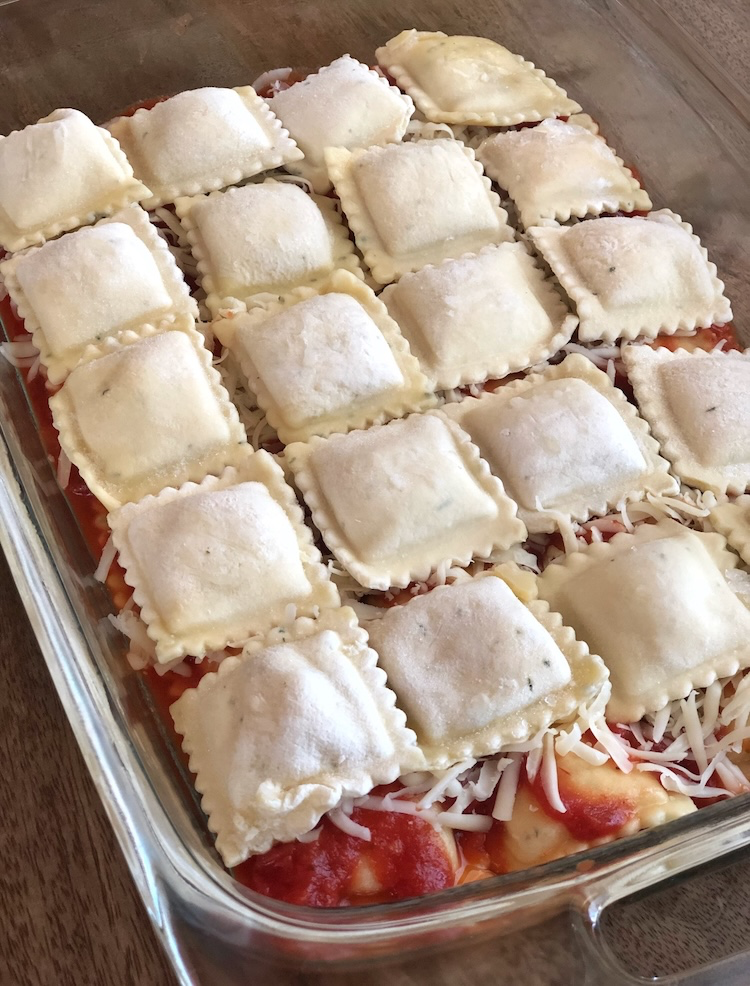
Kroger’s cheese ravioli — like most store-brand versions — is a shelf-staple version of a fresh pasta that’s been prepped and flash-frozen. The pasta shell is already par-cooked, so it softens fast once it hits hot water. The filling? Usually a ricotta-based mix with maybe some parmesan or romano folded in, depending on the brand. That means it’s creamy, low-structure, and prone to melting out the second the pasta starts to overcook or split open.
That’s the part people don’t always get. You’re not cooking it from raw. You’re reheating and finishing something that’s already halfway done. Which is why timing and temperature matter more than you’d expect.
The frozen state changes everything. The cheese filling goes from frozen to hot faster than the pasta cooks through. If your water’s boiling too hard, the outside flaps around while the middle stays cold. Stir too roughly and the seams start to fail. Cook too long and the whole thing turns to ricotta soup.
This is especially true with cheese ravioli. Meat fillings tend to hold up better — they’ve got more texture, more protein, and more weight inside the pasta. But cheese is soft from the start, and once it overheats, it thins out, leaks, and leaves you with little floating shells and cheese-slicked water.
So the goal isn’t just to heat them. It’s to balance the cook — hot enough to bring everything up to temp, gentle enough to keep it all intact, fast enough to stay al dente, and slow enough to keep the cheese where it belongs.
Let’s walk through the baseline technique — boiling frozen cheese ravioli the right way. Sounds basic, but there’s a difference between cooked and worth eating.
Boiling Frozen Ravioli — The Classic Method (Done Right)
This is where most people start — pot of water, ravioli from the freezer, big spoon, maybe a timer if they’re feeling responsible. But for frozen cheese ravioli, “boil and hope” doesn’t cut it. You need to be a little more deliberate if you want that soft filling to stay inside its pasta shell and come out with bite, not mush.
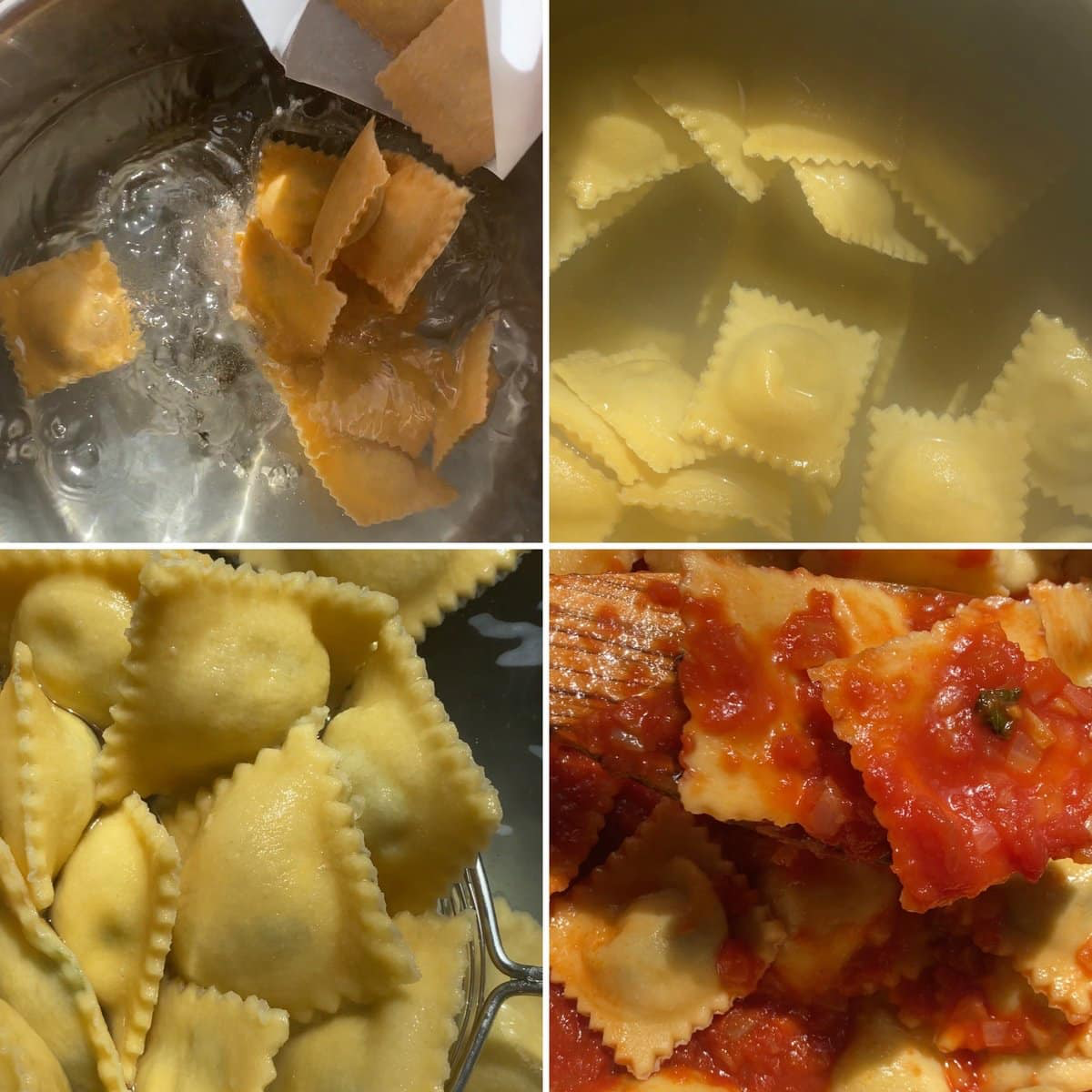
Start with plenty of water. A big pot gives you room for the ravioli to move without knocking into each other too hard. Crowded pots lead to sticking, tearing, and uneven cooking. Salt the water like you mean it — a tablespoon or two, depending on the pot. Just because the pasta is filled doesn’t mean it can’t benefit from seasoned water.
Bring the water to a gentle boil — not a raging, lid-clattering one. If the bubbles are too aggressive, they’ll toss the ravioli around and bash them into the sides of the pot like laundry in a machine. Keep it to a medium boil or a strong simmer.
Drop the ravioli in straight from frozen. No thawing. Stir gently, right away, with a soft hand and a wide spoon or spider. Don’t walk away just yet — the first 30 seconds are when they’re most likely to stick to the bottom or to each other.
Cook time is typically 4–6 minutes, but don’t just go by the bag. Use your eyes and your hands. People say, “they float when they’re done,” but that’s not reliable. They float because of trapped air — not because the center hit temp. The real test is texture. When the pasta softens just enough to feel flexible but still holds its shape when lifted with a spoon, they’re ready. You can also poke one gently with a fork — it should resist a little but not feel stiff.
Once they’re done, drain gently. If you’re tossing them straight with sauce, save a little pasta water — it helps the sauce cling and balances out the richness of the cheese. If you’re not saucing right away, drizzle a little olive oil over the ravioli or toss them with butter to keep them from sticking.
Whatever you do, don’t let them sit in the strainer. That’s how you end up with a sticky clump and torn pasta. Serve hot, or move fast.
That’s the base method — simple, but only if you pay attention. Get it right, and you’ve got plump ravioli with soft cheese filling that doesn’t escape on the way to the plate.
Pan-Fried or Skillet Ravioli — Crisp Outside, Soft Inside
Boiled ravioli is fine. But sometimes you want a little contrast — not just soft pasta with soft cheese, but a bit of golden crust, maybe even a subtle crunch on the edges. That’s where the skillet comes in. You’re not deep-frying. You’re not breading. You’re just taking something already cooked and giving it a better finish.
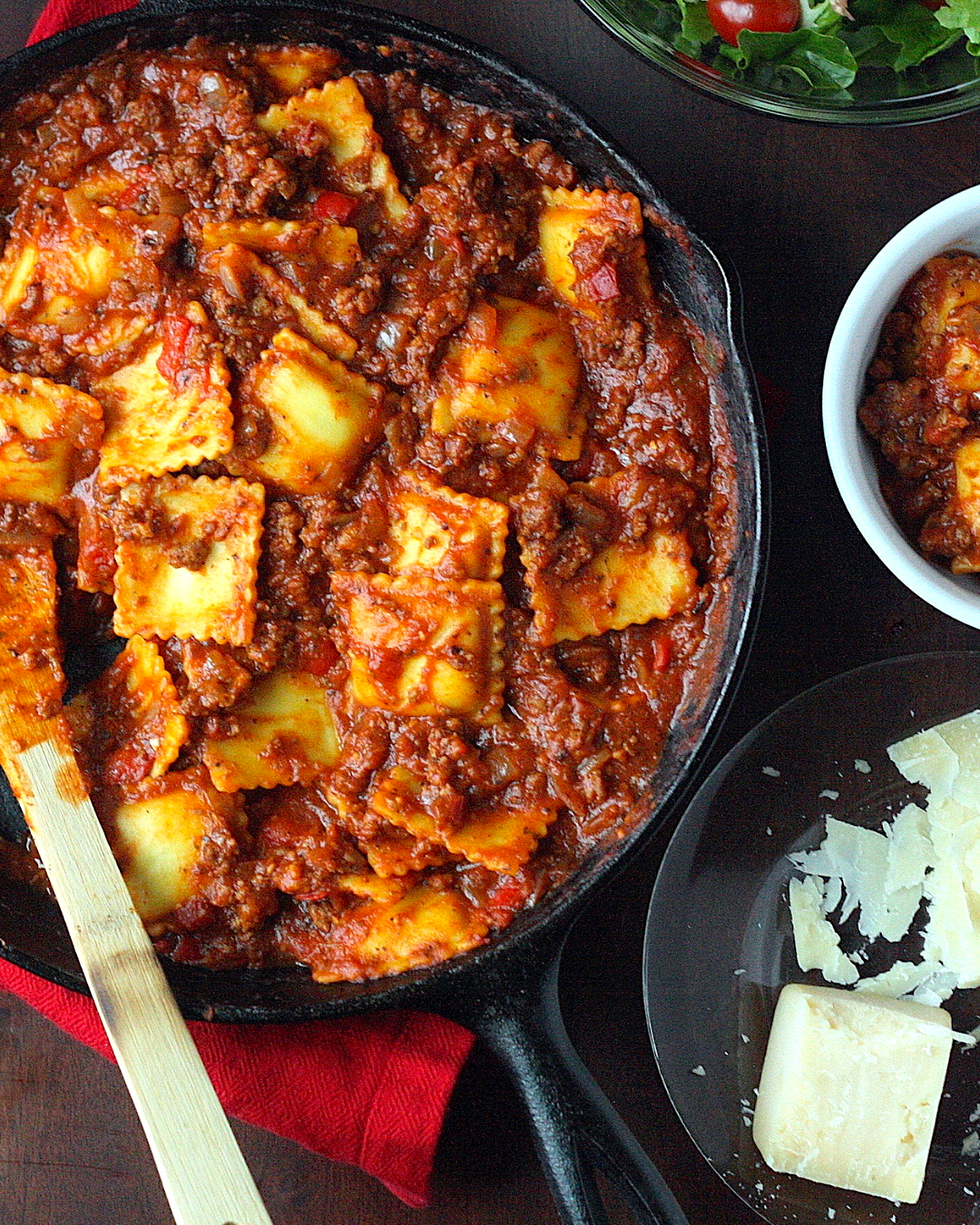
There are two ways to go here: boil then pan-fry, or pan-fry from frozen with a little liquid to help them cook through. For cheese ravioli, especially the soft kind like Kroger’s, the first method is safer. You get the inside cooked first, then finish the outside without risking a cold center or a blowout.
So here’s the move: boil the ravioli just shy of fully done — maybe a minute less than you normally would. Drain them gently, toss them with a little oil or butter to keep them from sticking, and let them cool just enough that they’re not fragile. Meanwhile, heat a nonstick or well-seasoned cast iron skillet over medium heat with a tablespoon or two of butter or neutral oil.
Once the pan’s hot and the fat’s melted, place the ravioli in with space between them. No stacking. No crowding. Let them sit. You want contact, not motion. After about two minutes, check the bottom of one. You’re looking for golden brown with a little crispness, not deep fry-style crust. Flip carefully and repeat.
The goal isn’t to toast them like crackers — it’s to add texture. A little bite on the outside, a little softness in the middle. That contrast makes a huge difference, especially if you’re serving the ravioli without a heavy sauce.
Speaking of which: skillet ravioli works best with light sauce or no sauce at all. Try brown butter and sage, olive oil with chili flakes and garlic, or a quick lemon-butter pan sauce. You can spoon something over, sure — but if you just drop these into a thick red sauce, you’ll lose the whole point of crisping them in the first place.
Bonus move: sprinkle in some grated parmesan toward the end and let it toast onto the edges. You’ll get little caramelized cheese crusts that feel like you planned more than you did.
This method turns frozen ravioli from “fine” into “you made what?” And all it takes is five extra minutes and a hot pan.
Baked Frozen Ravioli — Casserole Style
If boiling feels like maintenance and pan-frying feels like a flourish, baking frozen ravioli is comfort food mode. It’s what you do when you want something hot, cheesy, and hands-off. No water to watch, no need to flip anything — just layer it, bake it, and serve it like lasagna’s laid-back cousin.
You don’t need to thaw the ravioli. In fact, don’t. They’re easier to handle when frozen, and they’ll cook through just fine in the oven — as long as they’ve got moisture and heat to work with.
Start with a baking dish — 9×13 if you’re feeding a group, something smaller if you’re just making dinner for two. Spread a layer of sauce on the bottom. This isn’t just about flavor; it keeps the pasta from sticking and helps the ravioli steam and soften as they cook.
Layer the frozen ravioli on top in a single layer. They can be touching, but don’t stack them unless you’re building a multi-layer bake. Spoon more sauce over the top — enough to coat, but not drown. Then cheese. Mozzarella, maybe a little parm or romano for edge. You can repeat this layering process if you’re going for lasagna vibes. Just make sure there’s enough sauce between layers to keep everything cooking evenly.
Cover the whole dish with foil and bake at 375°F (190°C) for about 30 minutes. Covered baking traps steam, which is what softens the pasta and heats the filling without drying anything out. After 30 minutes, uncover it, add a little extra cheese if you want, and bake for another 10 to 15 minutes until the top is browned and bubbling.
You’ll know it’s done when the edges are bubbling and the ravioli are puffed and tender to the touch. Let it rest for 5–10 minutes before serving. The filling needs a second to settle, and it’ll be mouth-scorchingly hot if you dive in right away.
Want to build it out? Add sautéed spinach between layers. Or browned sausage crumbles. Or blobs of ricotta and a drizzle of pesto. The base is flexible — the only thing that really matters is heat, sauce, and giving the ravioli room to cook through without drying out.
This is the move for leftovers, for weeknights, for winter. It’s low effort and high reward, and it tastes like more work than it was — always a win.
Baked Frozen Ravioli — Casserole Style
If boiling feels like maintenance and pan-frying feels like a flourish, baking frozen ravioli is comfort food mode. It’s what you do when you want something hot, cheesy, and hands-off. No water to watch, no need to flip anything — just layer it, bake it, and serve it like lasagna’s laid-back cousin.

You don’t need to thaw the ravioli. In fact, don’t. They’re easier to handle when frozen, and they’ll cook through just fine in the oven — as long as they’ve got moisture and heat to work with.
Start with a baking dish — 9×13 if you’re feeding a group, something smaller if you’re just making dinner for two. Spread a layer of sauce on the bottom. This isn’t just about flavor; it keeps the pasta from sticking and helps the ravioli steam and soften as they cook.
Layer the frozen ravioli on top in a single layer. They can be touching, but don’t stack them unless you’re building a multi-layer bake. Spoon more sauce over the top — enough to coat, but not drown. Then cheese. Mozzarella, maybe a little parm or romano for edge. You can repeat this layering process if you’re going for lasagna vibes. Just make sure there’s enough sauce between layers to keep everything cooking evenly.
Cover the whole dish with foil and bake at 375°F (190°C) for about 30 minutes. Covered baking traps steam, which is what softens the pasta and heats the filling without drying anything out. After 30 minutes, uncover it, add a little extra cheese if you want, and bake for another 10 to 15 minutes until the top is browned and bubbling.
You’ll know it’s done when the edges are bubbling and the ravioli are puffed and tender to the touch. Let it rest for 5–10 minutes before serving. The filling needs a second to settle, and it’ll be mouth-scorchingly hot if you dive in right away.
Want to build it out? Add sautéed spinach between layers. Or browned sausage crumbles. Or blobs of ricotta and a drizzle of pesto. The base is flexible — the only thing that really matters is heat, sauce, and giving the ravioli room to cook through without drying out.
This is the move for leftovers, for weeknights, for winter. It’s low effort and high reward, and it tastes like more work than it was — always a win.
Let’s hit the crispy route — the air fryer. This is where frozen ravioli stops pretending to be dinner and turns into a snack that disappears faster than it should.
Air Fryer Ravioli — If You Want It Crispy
You’ve probably seen this one on some late-night scroll: crispy little ravioli, golden brown, dipped in marinara like mozzarella sticks with a passport. And yes — you can make them straight from frozen. But you need to approach it like what it is: a texture play, not a traditional pasta dish.
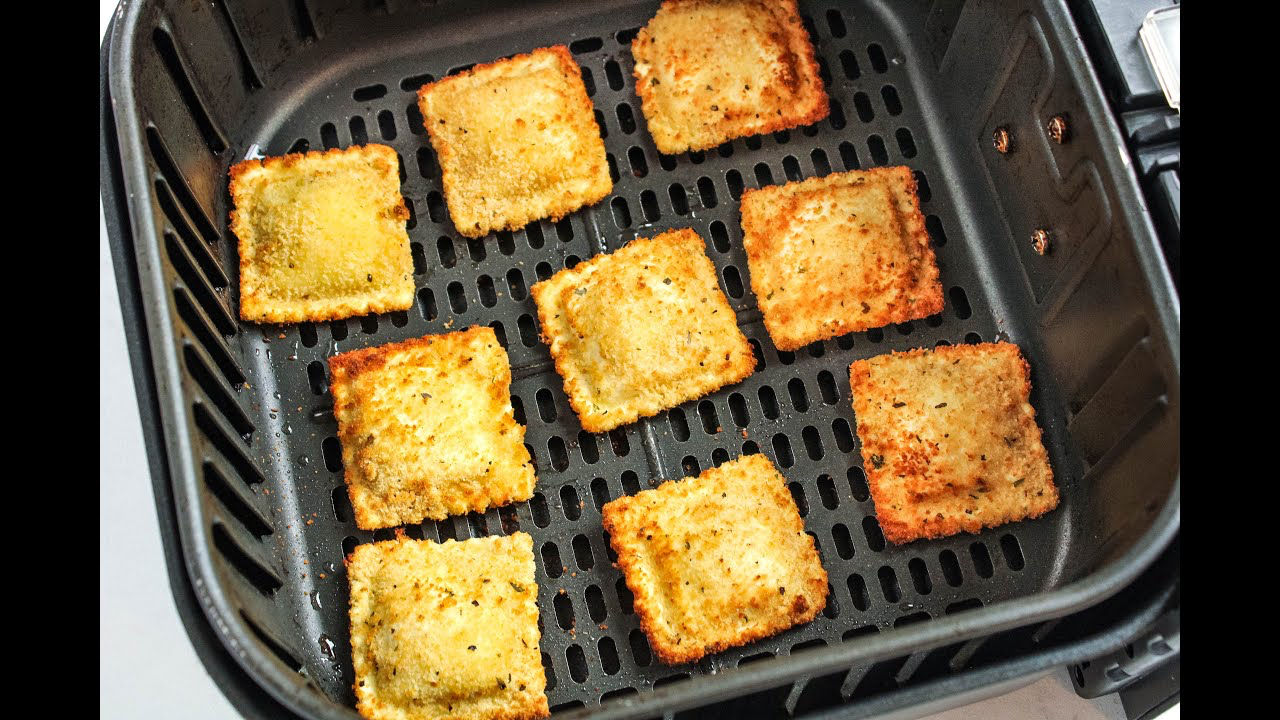
Air frying ravioli is less about heating and more about transforming. You’re taking soft, cheesy pasta and turning it into something that cracks a little when you bite into it. That means you can’t just throw plain frozen ravioli into the basket and hope for crunch. They’ll cook through, sure, but they’ll come out leathery, not crisp.
So here’s the move: take the frozen ravioli and toss them lightly with oil — just enough to coat. If you want the full appetizer treatment, dredge them in a mix of breadcrumbs and grated parmesan. Doesn’t have to be a full breading station — just a quick dip in egg or milk, then press them into seasoned breadcrumbs. Optional, but worth it.
Preheat the air fryer to 375°F (190°C). Arrange the ravioli in a single layer — no stacking, no crowding — and cook for 8 to 10 minutes, flipping halfway through. You’ll see the edges puff and crisp, the coating (if you used one) will turn golden, and the cheese inside will just start to soften. The key is pulling them before they burst. Once the filling gets too hot, it looks for a way out.
Don’t expect the inside to be molten — that’s not the point. You’re after contrast: crisp shell, creamy center, hot enough to hold together, not so hot that it leaks.
Serve immediately, with something to dip. Marinara is classic. Garlic butter works. Spicy tomato cream? Go for it. You’re not building a plate — you’re passing a bowl, and it’ll be empty before you set down the sauce.
Can you use the air fryer to cook ravioli like normal? Technically, yes, but don’t. It’s not built for that. The air fryer is for crispy things, not sauced ones. So save it for snack mode, party trays, or the nights when dinner is really just an excuse to eat with your hands.
Next: sauce. Not which brand to buy — but how to use it right. When to toss, when to spoon, and what to pair with cheese ravioli that won’t just smother the whole thing. Let’s keep going.
Let’s get into the part that makes or breaks how frozen ravioli lands on the plate — the sauce. Not just which one to use, but how to use it so it complements instead of overwhelming.
Saucing It — When, How, and Why It Matters
Frozen cheese ravioli doesn’t have a strong voice. It’s mild, soft, and rich — basically pasta wrapped around a dairy pillow. Which means if you sauce it wrong, you’ll either drown it or flatten it. The key is matching the tone, not trying to shout over it.
Start with this: sauce and ravioli should both be hot. Always. If you add cold sauce to hot ravioli, the whole thing seizes up. The cheese stiffens, the pasta cools unevenly, and suddenly it feels like you’re chewing through leftovers. Reheat the sauce while the ravioli’s cooking — or better yet, heat it in a separate pan and toss the cooked ravioli in right before serving.
Red sauces are the default — and they work, as long as they’re not too heavy. Think tomato-basil, not meat-laden marinara. Cheese ravioli doesn’t need bolognese. If your sauce is thick, loosen it with a splash of pasta water or a drizzle of olive oil. Let it coat, not blanket.
Brown butter and sage is the fastest upgrade on the list. Melt butter, toast it until it smells nutty, add fresh or dry sage, maybe a few chili flakes or a squeeze of lemon. Spoon over pan-fried or boiled ravioli and you’re done. It clings without smothering and brings contrast without acidity.
Garlic oil or a simple olive oil and herb toss is ideal for pan-fried ravioli. You’ve already got texture — you don’t need a wet sauce that makes everything soggy. Just enough oil to carry flavor, plus fresh herbs, maybe a little parm, maybe a squeeze of lemon.
Cream sauces? Risky. They double down on the cheese filling and can get heavy fast. If you go there, keep it thin — more cream than roux, with something bright (lemon, garlic, white wine) to cut through the fat. Use sparingly. This isn’t fettucine.
And finally: don’t sauce and wait. Cheese ravioli doesn’t hold well once it’s tossed. It starts to slump, stick, and absorb whatever it’s dressed in. Either sauce-to-serve, or toss just before plating and eat it hot. If you need to hold it, keep the sauce and ravioli separate until the last second.
Saucing is where frozen ravioli either shows up or gets lost. Treat it like part of the dish, not a topping — and it’ll carry more weight than the label on the bag ever suggested.
How to Avoid the Most Common Mistakes
Overcooking is the biggest one. Cheese ravioli cooks fast — usually five minutes or less. Go past that and the pasta softens too much, the filling thins out, and the seams start to fail. The ravioli don’t burst right away, but they start leaking. The result: watery filling, soggy pasta, and ricotta clouds floating in your cooking water. Watch the pot. Test early. Trust texture over the timer.
Undercooking doesn’t happen as often, but when it does, it’s obvious. The outside feels done, but the center is cold or firm. It happens when you don’t stir at the beginning or when the boil isn’t steady. Give it enough time, but don’t rush it. Let the ravioli float and soften. If you’re not sure, pull one, let it cool for ten seconds, and take a bite. Trust your mouth, not just the float.
Tearing the pasta usually comes from stirring too aggressively, using the wrong tools, or boiling too hard. Frozen ravioli is delicate once it softens. You don’t need to baby it, but you do need to treat it like something filled, not solid. Use a wide spoon or spider. Stir slowly. Don’t stab. And don’t pour it out into a colander like spaghetti — tilt and scoop if you can.
Boiling too hard is another stealth killer. A full, rolling boil makes the ravioli bounce and collide like bumper cars. That’s how you get surface tears and popped seams. A strong simmer or gentle boil gives you control without chaos. Think bubbles, not waves.
Not salting the water leaves everything flat. Yes, the filling has cheese. No, that’s not enough. The pasta still needs seasoning. A tablespoon of kosher salt per pot is enough to make a difference. It won’t make the ravioli salty — it’ll just stop it from being bland.
Letting them sit before saucing turns everything gluey. As soon as ravioli comes out of the water, it starts cooling and drying. The starch on the outside goes tacky. If it’s not being tossed in sauce, it needs a drizzle of oil or butter right away. Otherwise it clumps, splits, and feels like leftovers even before it hits the plate.
These mistakes are common because frozen ravioli looks simple. And it is — once you know how to handle it. But if you treat it like dry pasta, or walk away thinking the timer will save you, it pushes back.
Ravioli Add-Ins and Upgrades
A bag of frozen cheese ravioli will fill a plate, but it won’t always finish a meal. It’s soft. It’s mild. It doesn’t have contrast or stretch unless you build some in. That doesn’t mean adding complexity — it just means knowing what to drop in, layer on, or spoon over so it tastes intentional.
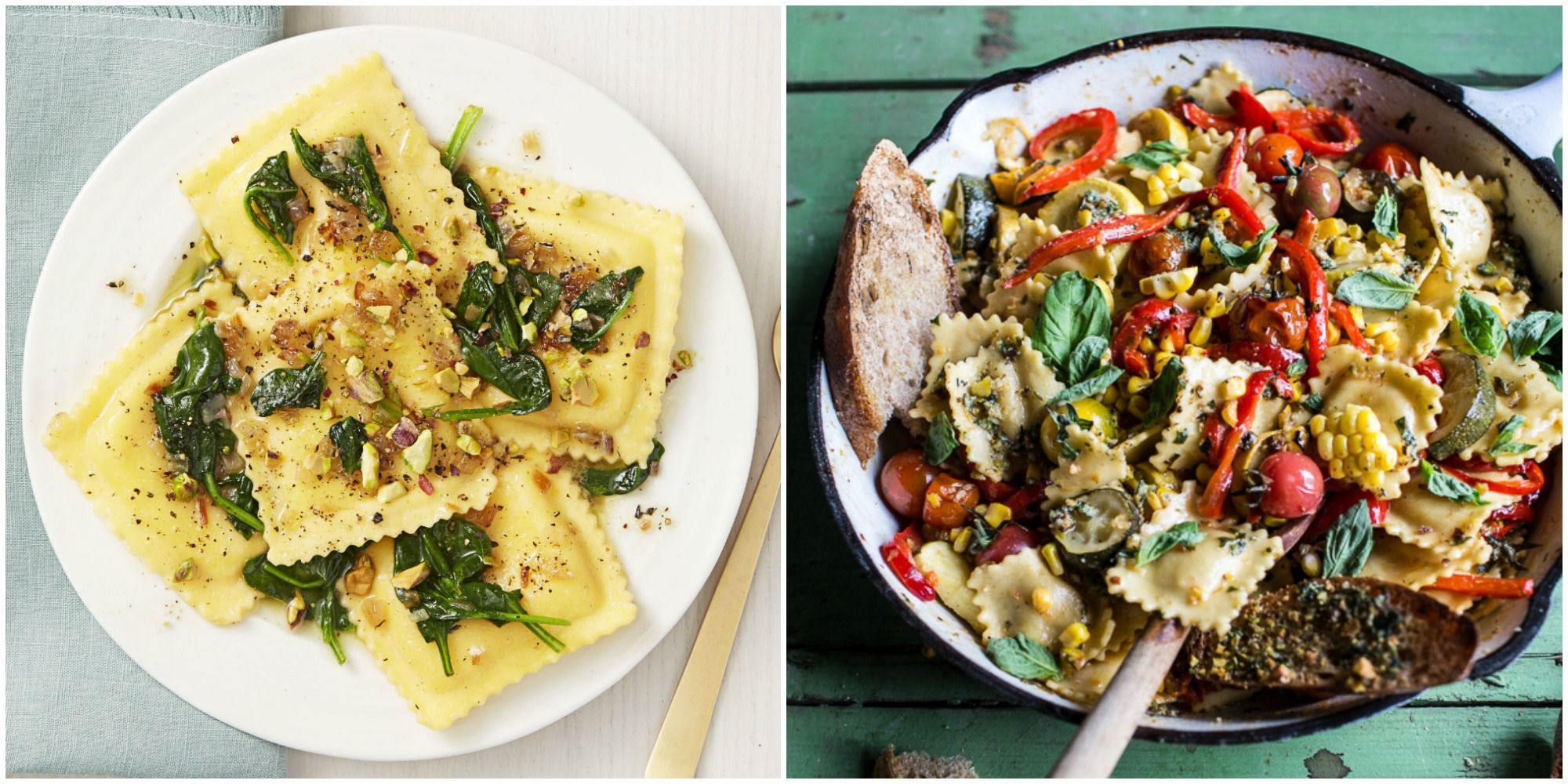
Start with vegetables that don’t need a full second pan. Baby spinach, frozen peas, halved cherry tomatoes, zucchini cut thin — they can all go into the boiling water with the ravioli in the last minute or two. They’ll soften just enough to fold in, and they’ll add a different kind of texture without slowing anything down. Spinach wilts fast. Peas just need a quick heat-through. Tomatoes burst and sweeten a little. Zucchini gets tender if it’s cut thin enough. No need to overthink it.
Want more heft? Add pre-cooked protein. Leftover rotisserie chicken, browned Italian sausage, pancetta crisped in a pan, even canned white beans — all of it works. The trick is keeping the scale right. You’re not trying to build a new dish. You’re just giving the ravioli something to land next to or mix into. Chop, toss, done.
If the pasta feels too soft, throw texture on top. Toasted breadcrumbs tossed in a little olive oil or butter can go right over the finished plate. They catch sauce, absorb a little of the cheese steam, and give every bite some crunch. If you’ve got time, toss in herbs or garlic powder while they toast.
Same goes for cheese that finishes, not fills. The ravioli already has a ricotta-based center. But topping with shaved parmesan, crumbled feta, or a dollop of burrata takes it in a different direction. You’re not doubling down on richness — you’re adding contrast. Salty cheese brings edge. Soft cheese brings drama.
And then there are herbs. Nothing dried. Nothing cooked. Just a fistful of something fresh chopped up at the end and scattered on top. Parsley is always safe. Basil is better if there’s tomato sauce involved. Thyme plays well with brown butter. Mint works if you’re doing lemon or light cream. You don’t need a lot — just enough to remind you this isn’t just a bag of frozen pasta. It’s food you built on purpose.
Storage, Leftovers, and Reheating
Frozen ravioli is easy to cook fresh. Reheating it? Not so much. Once it cools, the pasta firms up, the filling tightens, and whatever sauce you had starts to separate or disappear into the noodles. But that doesn’t mean you have to eat it cold or toss it.
Storing: Let the ravioli cool to room temp before you do anything. If you seal it up while it’s still hot, it’ll steam itself into a sticky clump. Store it in a shallow container if possible — single layers are better than a pile. If it’s already sauced, spoon a little extra sauce over the top before sealing it. If it’s unsauced, drizzle with olive oil or dot with butter so it doesn’t dry out in the fridge.
Shelf life: You’ve got about 3–4 days in the fridge before things get weird. The filling can start to get grainy after that, and the pasta loses its edge. You can push it to five if it was stored dry and you’re planning to reheat it into something baked or saucy.
Reheating: The microwave works — but only if you treat it like steam, not fire. Add a splash of water, broth, or sauce. Cover it with a damp paper towel or lid. Go in short bursts. Stir or flip halfway if it’s in a pile. You’re not trying to blast it back to life — you’re just warming it gently.
Better yet: use a skillet with a lid. Add a splash of water or stock, put the ravioli in cold, cover, and heat over low. Let the steam rehydrate the pasta and soften the filling. Once it’s warmed through, you can crank the heat and add a little oil or butter to crisp the edges if you want.
Avoid baking already-cooked ravioli unless you’ve got a plan — like turning it into a baked pasta dish with more sauce and cheese. On its own, baked leftovers go dry fast.
Freezing leftovers? Not ideal. The pasta texture takes a hit, and the filling might split when reheated. If you freeze it, do it with plenty of sauce and reheat slowly. Still, it’s better to freeze uncooked ravioli than to try to re-freeze it after it’s been cooked.
Bottom line: frozen ravioli is easy to make. Keeping it good after dinner just takes a little care — heat it gently, add moisture back in, and don’t let it sit in the fridge like you forgot it.
FAQ — Frozen Ravioli, Real Questions
Frozen ravioli seems like the kind of thing you shouldn’t need to ask questions about — until you’re five minutes in and wondering why they’re all stuck together or why your sauce suddenly looks like soup. These are the questions that come up the first time you cook them and the fiftieth. Consider this the quick reference guide for when you’re standing over the pot or staring into the air fryer, wondering what went wrong.
Do I need to thaw frozen ravioli first?
No. Cook it straight from frozen — thawing softens the pasta and makes it more likely to tear or leak. Just drop it into boiling water or layer it directly into a baked dish.
Why are my ravioli falling apart?
Too much heat or too much movement. If the boil is too aggressive or you stir hard, the pasta seams split. Keep the boil gentle and stir carefully early on, then leave them alone.
Can I cook frozen ravioli directly in sauce?
Yes, but only if the sauce is loose and there’s a lid. Simmer over low heat for 10–15 minutes. Add water or broth if it starts drying out. Covering is key — it needs steam to cook through without burning.
Can I freeze cooked ravioli?
You can, but expect softer texture and slightly separated filling on reheat. If you do freeze it, add sauce and wrap tightly. Reheat low and slow, preferably in a covered dish.
Why is my filling leaking out?
Usually from overcooking or letting it sit in the water too long after draining. Pull the ravioli as soon as they’re done, and don’t let them hang out in the pot or strainer.
Can I make ravioli ahead and reheat it later?
Yes, just store it flat and separate if possible, with a bit of oil or sauce to keep it from sticking. Reheat gently — steam in a pan or cover in the microwave with a splash of water.
Is it safe to eat if the cheese is still soft in the middle?
Yes — the filling should be soft. As long as the pasta is tender and the filling is hot, you’re fine. If it’s cold or grainy, it’s undercooked.
Do I have to boil ravioli before baking it?
No. You can bake it straight from frozen as long as there’s enough sauce and steam in the dish. Just cover it with foil for the first 30 minutes so it cooks through before the top browns.
Most of the issues with frozen ravioli come down to heat, timing, and how you handle it once it’s out of the water. Once you’ve got a feel for those, the rest gets easy. Cook it with a little care, sauce it hot, and you’ll stop thinking of it as frozen food and start treating it like dinner with a shortcut.
Closing: It’s Still Frozen Ravioli — But It’s Dinner Now
You’re not fooling anyone — this started as a bag from the freezer. But that doesn’t mean it can’t end as a real meal. If you handle it with a little care, balance the timing, sauce it while it’s hot, and maybe add something sharp or green or crispy on top, it stops feeling like “just ravioli” and starts feeling like food someone cooked on purpose.
You don’t need a fresh pasta machine. You don’t need Nonna. You just need a pot of water, five minutes of attention, and the willingness to treat even the easy stuff like it deserves to be good.
And if you screw it up? You’ve got another bag in the freezer. You’ll get it right next time.